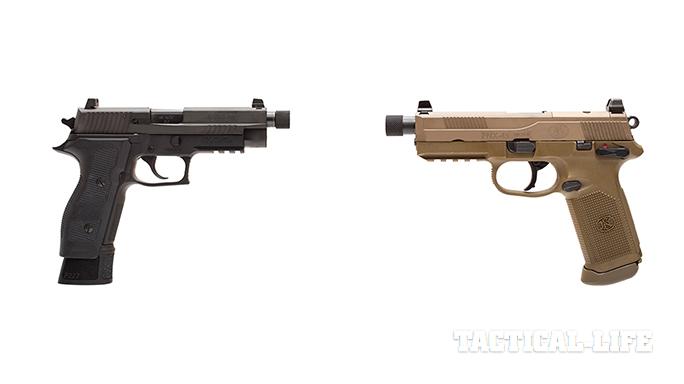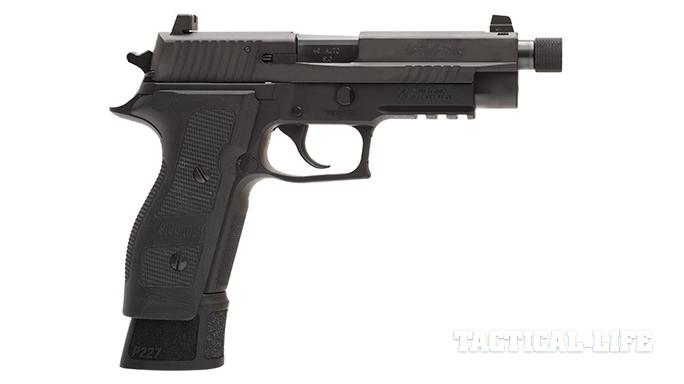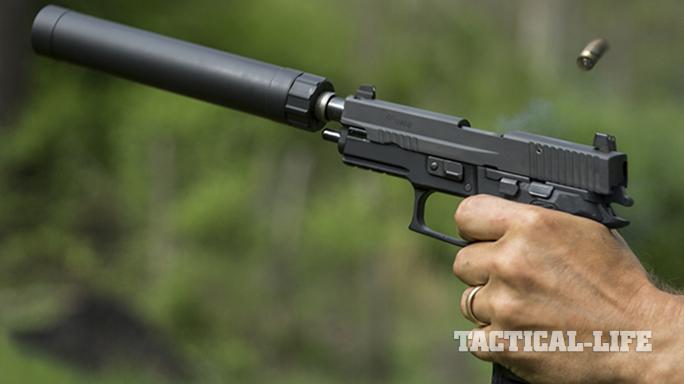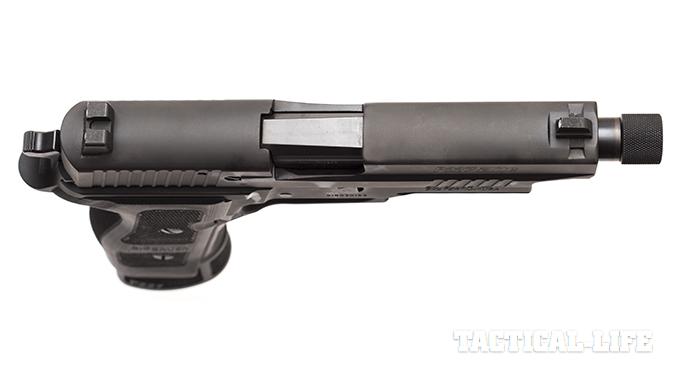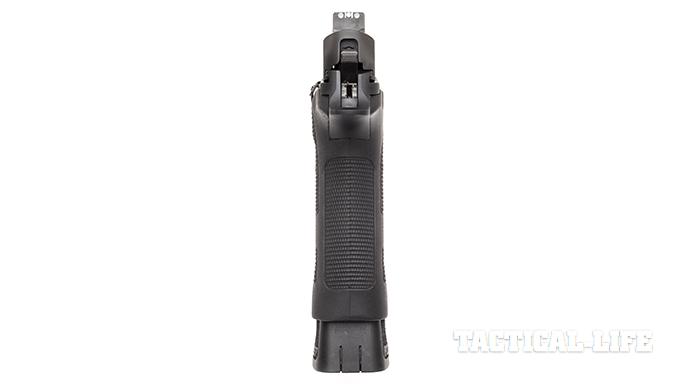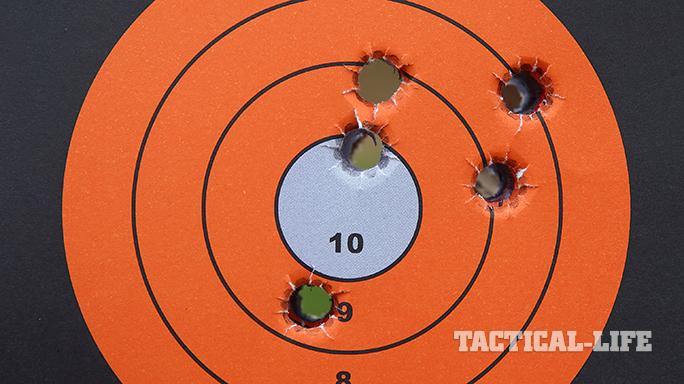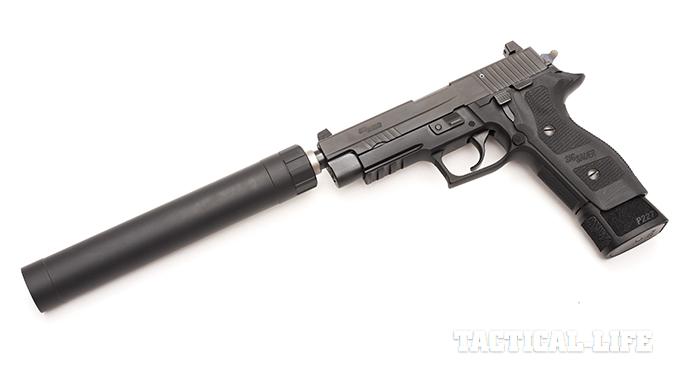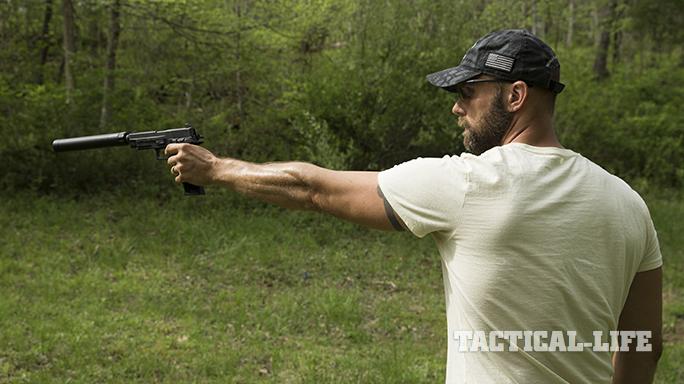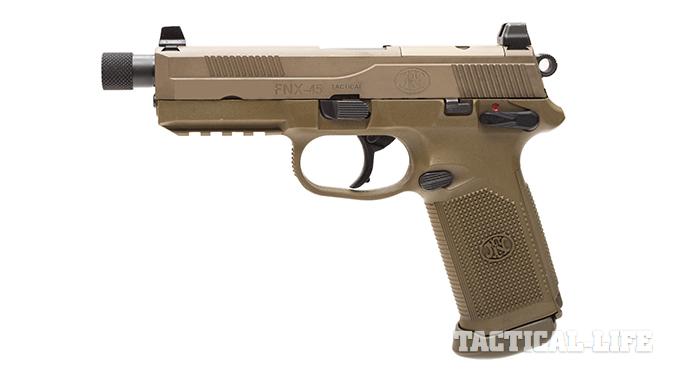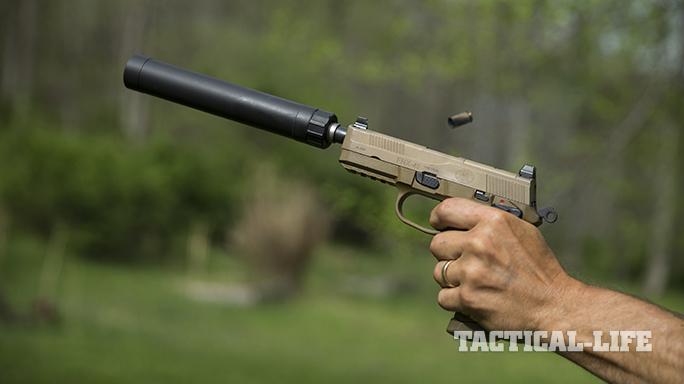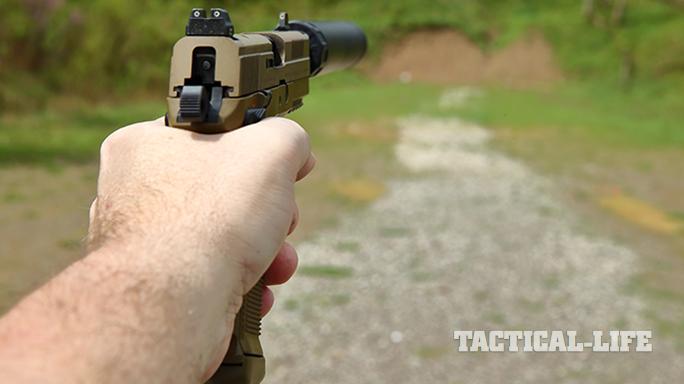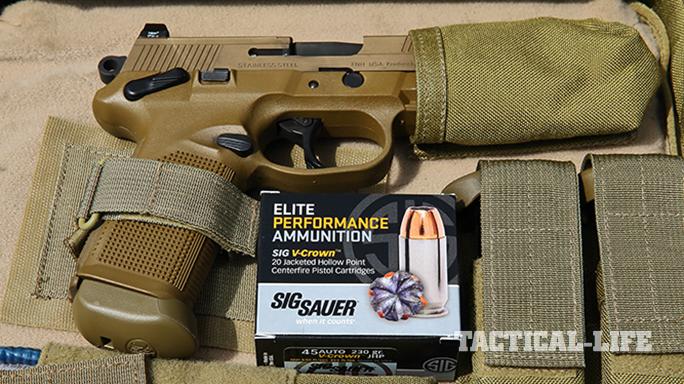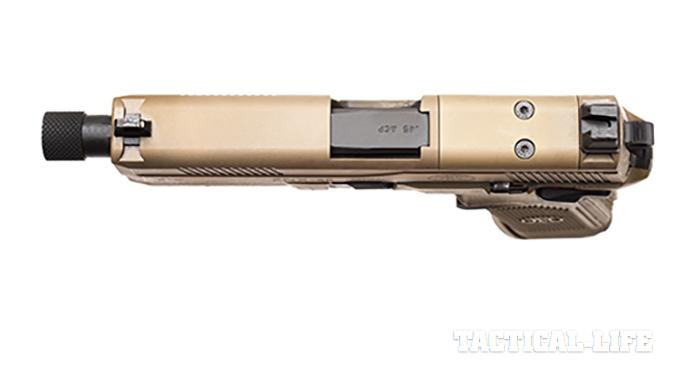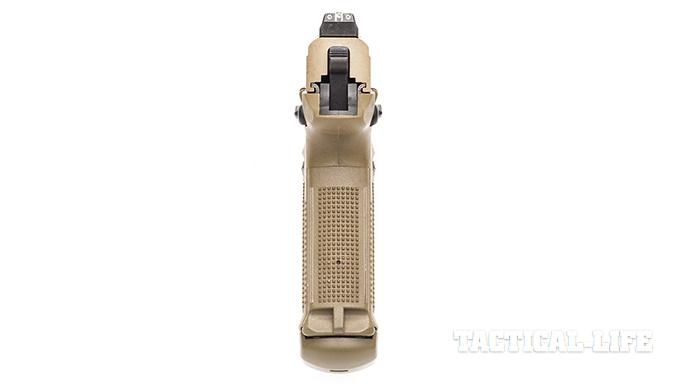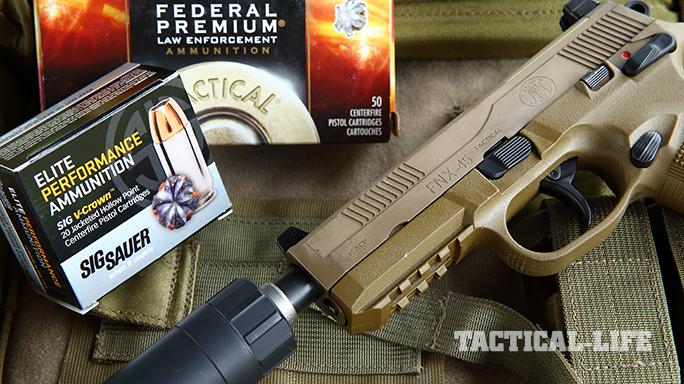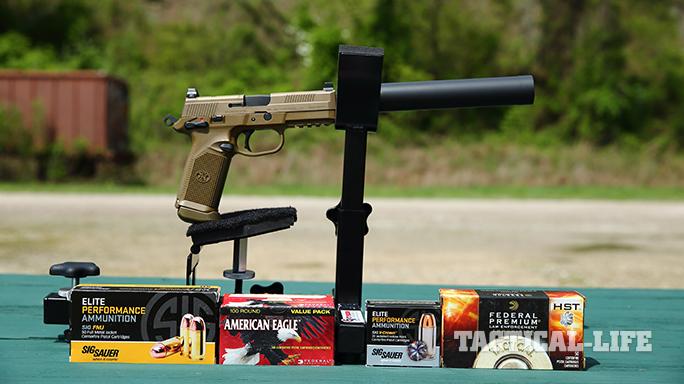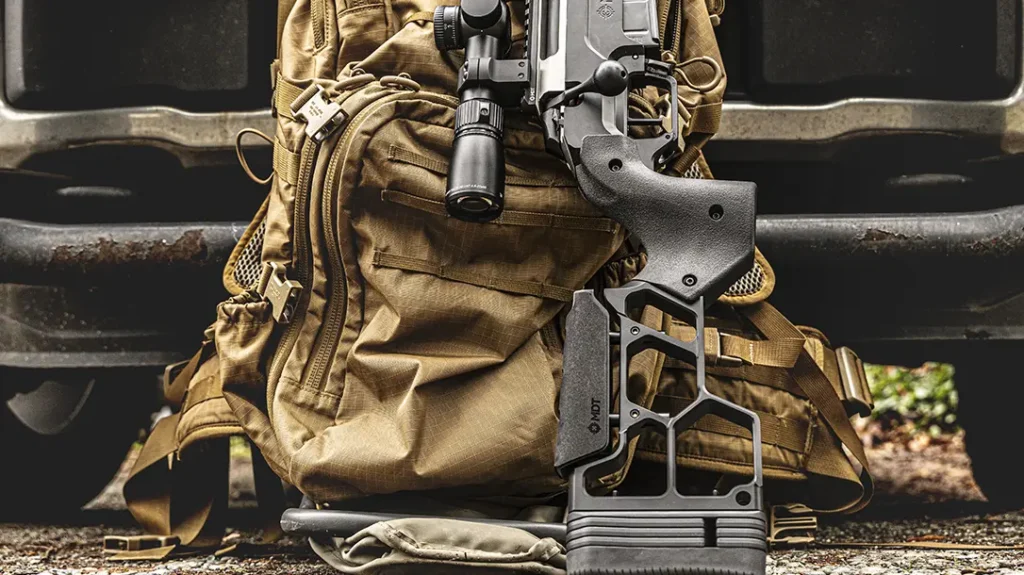As a few rays of hope start spilling over the legislative horizon, some enthusiasts are getting excited at the prospect of legally purchasing suppressors without NFA restrictions, as proposed in the Hearing Protection Act. If that happens, suppressor-ready pistols, or hosts, will become even more popular. Of course, it never hurts to see what’s currently on the market and get a head start on the process if you’re one of those folks chomping at the bit.
For this edition of “Tale of the Tape,” we’ll take a look at a couple of tactical heavyweights in the Sig Sauer P227 TACOPS and the FNX-45 Tactical. Both are high-capacity pistols chambered for the stout .45 ACP round, yet there are significant differences between the two that may appeal to different audiences. Contrasting one against the other will hopefully provide a good foundation for those new to the arena.
Sig P227 TACOPS
A relatively new addition to the Sig Sauer lineup of pistols, the P227 TACOPS offers a lot in terms of style, ergonomics and shootability. It hails from the factory with a TruGlo Tritium/Fiber-Optic (TFO) front sight and a SIGLITE rear. It also comes with a standard 4.4-inch barrel as well. However, for this review, Sig Sauer sent a threaded barrel along with a set of suppressor-height night sights.
Advertisement — Continue Reading Below
- RELATED STORY: Sig’s Matchmaker – The 1911 Match Elite Stainless
The P227 TACOPS is a rather large pistol, especially with the four included 14-round, extended magazines that protrude somewhat from the grip. It has an overall length of 7.9 inches with the standard barrel, a height of 6.5 inches with a magazine in place, a width of 1.5 inches and an unloaded weight of 35 ounces. It’s definitely a full-sized tactical weapon intended to wreck someone’s day.
The slide is made of stainless steel with a matte black Nitron finish, and the P227 has a hardcoat anodized aluminum frame. Also, the P227 is double-action/single-action (DA/SA) pistol, meaning the first shot with the hammer down has a longer DA pull with each subsequent shot being fired via a shorter and lighter SA trigger pull. There is no manual safety, but as standard with other classic Sig pistols, a decocking lever is present to facilitate a safe hammer drop after firing.
FNX-45 Tactical
Enclosed within an attractive and functional nylon carry case, the FNX-45 Tactical is ready from the start to hit the range as a suppressor host. It comes with suppressor-height night sights already installed as well as a 5.3-inch barrel with standard 0.578×28-tpi threading and a knurled thread protector. Included in the package are three 15-round magazines, providing enough firepower to engage multiple threats quite handily.
Advertisement — Continue Reading Below
In contrast to the Sig P227 TACOPS, the FNX-45 Tactical has a polymer frame that, while a little large, packs away a higher number of rounds in a more compact and shorter grip. This makes the grip frame less obtrusive and slightly more manageable to carry.
The sample I received for this article was FN’s FDE version. Its mode of operation is somewhat similar to the P227 in that it’s also a DA/SA pistol. However, it goes one step further in that the safety can be flicked upward when the pistol is cocked, allowing for “cocked and locked” carry similar to a 1911. In addition, the safety can be flipped all the way down to decock the pistol as well. In essence, this firing mechanism allows for multiple carry modes depending on user preference and skill level.
Almost the same in weight, the FNX-45 Tactical tips the scales at 33.3 ounces unloaded. It has an overall length of 7.9 inches, a height of 7 inches and a width of 1.58 inches, making both pistols approximately the same size in all dimensions except height.
Advertisement — Continue Reading Below
Crossing The Ropes
Specs can tell you only so much. Performance is what it’s all about, and that’s why it was time to put the two beefy contenders head to head with each other. For testing the two pistols and their ability to act as suppressor hosts, I brought out a brand-new Ti-RANT .45 sound suppressor from Advanced Armament Corporation (AAC).
While shooting drills and for accuracy, I had the chance to really compare the triggers on both pistols. The Sig P227 TACOPS’ trigger pull averaged 9.5 pounds in DA mode and 4.25 pounds in SA mode. The FNX-45 Tactical had the same 9.5-pound pull in DA, but the SA pull was slightly lighter than 3.9 pounds. And even though both pistols had 9.5-pound DA trigger pulls, the P227 TACOPS’ metal trigger felt much cleaner and crisper in use than its opponent’s.
The accuracy portion of the testing was a bit of a mixed bag when it was all said and done. I fired five-shot groups with each gun from a CTK Precision compact shooting rest at 25 yards. With the AAC Ti-RANT installed, the accuracy of both pistols diminished for the most part, though the P227 enjoyed the accuracy edge when it came to suppressed fire.
Advertisement — Continue Reading Below
Using Sig Sauer’s 230-grain Elite V-Crown JHP ammunition, the average group size for the FNX-45 Tactical was 3.38 inches, while the P227’s average size was 2.69 inches, with a best five-shot group overall (while suppressed) at 2.25 inches. The roles were reversed a bit when the suppressor came off for another round of accuracy testing.
This time, the FNX-45 Tactical edged out the P227 TACOPS with a 2.11-inch average versus a 2.38-inch average, respectively. However, this comparison is about the pistols acting as suppressor hosts, so the reader will have to decide which results are the most important.
Recognizing the P227’s home-field advantage with the Sig Sauer ammunition, I changed out the ammo for both pistols and tried again. I shot some Federal Premium HST +P rounds, and the results turned out to be eerily similar to the first round of testing.
Advertisement — Continue Reading Below
More Rounds
For general plinking and drills, I had both 230-grain Federal American Eagle FMJs and 230-grain Sig Sauer FMJs on hand to round out the testing to check for fit and function. Despite being considered practice ammunition, both of these loads did just as well as the premium rounds while shooting off hand.
With regard to comfort, ergonomics and handling while shooting, it was a close call between the two. While the P227 had a nicer feel in the hand with its Hi-Power-like backstrap, the FNX-45 seemed to point more naturally and get on target quicker. This is a matter of user preference, so that point is not to be considered an objective fact.
During actual fire, however, I felt the Sig was much more comfortable to shoot. Even though the FNX-45 can be carried cocked and locked like a 1911, the safety also acts as a decocker, meaning that you can’t ride the safety while shooting like you can with a 1911. If you do, you can inadvertently decock the gun while firing. This left me with having to keep my thumb under the safety while firing for a comfortable grip, but this caused the safety to dig into the top of my thumb during recoil. It wasn’t excruciatingly painful, but it still wasn’t as pleasant to shoot as the P227.
Advertisement — Continue Reading Below
The P227 also had another advantage with its slide release. The P227’s slide release is located farther back on the slide, behind the decocker, and it was very easy to engage. Conversely, the slide release on the FNX-45 was rather small and located forward of the safety. I had to torque my hand around just a little to be able to reach and manipulate the slide release, and a couple of times this operation wasn’t hiccup-free, requiring a second attempt to release the slide.
By round seven, the FNX-45 got its own moment in the spotlight and found its stride while shooting for reliability. All four loads fired through the FNX-45 fed without fail, and there were no issues with ignition. However, the P227 had a couple of times when its head bobbled a bit and went to a knee a time or two.
The premium V-Crown and HST loads did just fine with a total of about 120 of these rounds going through the P227. The Sig experienced two failures to feed and two failures to fire with the Federal American Eagle rounds. It also experienced one failure of each type with the Sig FMJs as well. The failures to feed saw the bullet still in the magazine with a nose-down attitude, requiring a re-racking of the slide to get the pistol rolling again.
Advertisement — Continue Reading Below
The Verdict
With an MRSP of $1,349 for the FNX-45 Tactical and $1,413 for the Sig Sauer P227 TACOPS, both pistols are basically playing around at the same end of the price spectrum. Though, since the threaded barrel and suppressor sights are extra with the P227, it will take around another $330 dollars to be able to rock a suppressor.
The P227 offers one more magazine (four total) than the FNX-45 Tactical for the money. However, the FN offers a cut-out on top of the slide, making it ready straight from the factory to install various brands of reflex sights. Depending on your preferences, one attribute might be more important than the other.
While the FNX-45 Tactical fed all of the rounds reliably, the P227 TACOPS stumbled a bit with both types of ball ammunition, though this can happen with almost every manufacturer and can usually be sorted out easily by the factory. On the flip side, the P227 TACOPS felt more comfortable in the hand, and the controls were much easier to access and engage. The capacity of the magazines is essentially the same for both pistols.
Advertisement — Continue Reading Below
It’s dealer’s choice as to which pistol suits each user the best. Either way, both platforms offer a solid foundation for hosting a sound suppressor. Each reader will have to take the decision from here and make that final call.
P227 TACOPS Specs
Caliber: .45 ACP
Barrel: 4.4 inches
OA Length: 8.5 inches
Weight: 35 ounces (empty)
Grip: G10
Sights: TruGlo TFO front, SIGLITE rear
Action: DA/SA
Finish: Matte black
Capacity: 14+1
MSRP: $1,413
FNX-45 Tactical Specs
Caliber: .45 ACP
Barrel: 5.3 inches
OA Length: 7.9 inches
Weight: 33.3 ounces (empty)
Grip: Polymer
Sights: Three-dot night
Action: DA/SA
Finish: Flat Dark Earth
Capacity: 15+1
MSRP: $1,349
For More Information
SIG SAUER
sigsauer.com
This article was originally published in “Combat Handguns” September/October 2017. To subscribe, visit outdoorgroupstore.com.
